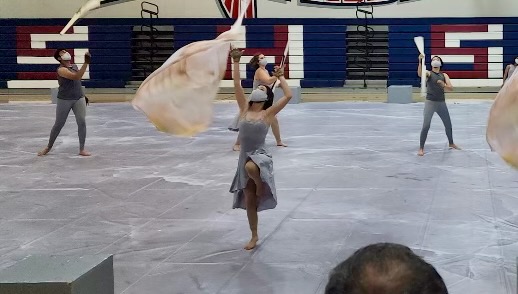On the way to the Cupertino Tournament of Bands in October 2021 (the first color guard competition of the season), Esabella Fung remembers hearing a horrible sound come from the back of her outfit. As she inspected her uniform, she discovered a barely visible rip at the bottom of the zipper seam.
“When it broke I felt a little self-conscious for a while,” said Fung, who is now a junior and now an assistant captain. “Even though you couldn’t see [the hole], the knowledge of it made me uncomfortable.”
Despite being early into the season, Fung was just one of many team members who faced wardrobe malfunctions or chafe marks on their necks and shoulders from the guard’s sleeveless uniform, the team’s main outfit for the year’s performances.
Color guard uniforms are traditionally form-fitting (but not extremely tight) to allow for the physical movement required in the activity. For Fung and several others interviewed by The Falcon, the outfits contributed to a sense of feeling self-conscious.
“Our costumes were body-tight and it felt like everyone was always staring at us,” Fung said. “So we felt like we always had to suck in [our stomachs], even if we had nothing to suck in.”
Adding to the problem was that she had struggled with feelings of body dysmorphia for years. At various points, she viewed gaining weight during puberty to be “disgusting,” as being underweight had always been the norm for her, distorting her self-image.
So, when Fung initially joined color guard sophomore year to fulfill her physical education credits, she was overwhelmed with feelings of self-doubt about her capabilities and was also insecure about her body.
“I often felt exposed while performing and festered bad habits of avoiding eating during competition days as a result,” Fung said.
She also said she felt stressed when comparing her performance to others. This is partly because she joined color guard as a sophomore, instead of as a freshman like many others in the group.
Fung said she held herself to a higher standard and often became stressed, finding it difficult to maintain her performance quality. The pressure she put on herself and her insecurities led her to spend an unhealthy amount of time practicing at home and even at school during tutorials and breaks. Fearing failure, she prevented herself from trying new skills to “go full out” and reach her maximum potential.
Now, more than one year later, Fung’s attitude and mindset have evolved. Time has allowed her to adjust to the new activity, and improving her skills has led her to gain more confidence in general — alleviating many of the negative feelings she had about her body.
“Ironically, as time passed, I was doing more physical activity, which allowed me to develop an appetite and actually eat,” Fung said. “I got used to performing and, after being in the sport for long enough, I realized that no one really cares about the way your body looks. In color guard, people are always watching you, but they aren’t looking at you in the overcritical way I viewed myself.”
She now holds one of six leadership positions in color guard, something that has also deepened her perspective.
“[My position actually] makes me take a step back sometimes and look at how I’m acting and reflect on if [my actions] truly align with how I want color guard to be perceived,” Fung said. “I want the program to be respected and need to always be setting a good example.”
To avoid burnout, she tries to take a step back occasionally to reflect on her improvement and development as a whole and focus on progress rather than on a skill she might have difficulty mastering.
With body dysmorphia and insecurities fading away as she has become more comfortable with peers and performing, Fung has found more motivation and focus on improvement.
“I love this sport so much, and because I spend so much time with my teammates it pushes me to be my best because I don’t want to let anyone down,” Fung said.


























